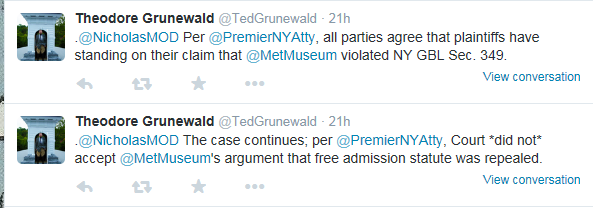The Appellate Division, First Department, has affirmed the 2013 dismissal of claims in a lawsuit challenging the admissions policy of the Metropolitan Museum in New York.
The Met gained its present location as part of an agreement with the City of New York and 19th-century statutes that together provide that the museum may stay rent-free only so long as it is open to the public free of charge on multiple days each week. At some point, the Met began soliciting voluntary donations from visitors even on those free days. Theodore Grunewald and Patricia Nicholson, the plaintiffs in the first of the two lawsuits claimed that the signs in the museum and the links on the website are misleading in that they suggest a mandatory admission fee, and that the Met has intentionally misled the public to that effect. A second suit made substantially the same allegations on behalf of a different group of plaintiffs (Filip Saska, TomášNadrchal, and Stephen Michelman).
The plaintiffs claimed to be beneficiaries of the Met’s lease contract with the city of New York. A third party beneficiary is someone whom a contract contemplates will be benefitted in some way, and that person ordinarily has standing to bring a claim to enforce the contract (like the beneficiary of an insurance contract, for example). Since the city was not a party, and the court considered whether the plaintiffs even had standing to bring the claims as third-party beneficiaries. The Supreme (trial) Court found that they are not. Although the Met’s arrangement was clearly designed to benefit the public, that does not convert every member of the public into a third-party beneficiary.
The second question was whether the statute authorizing this arrangement allowed citizens to bring suit, in what is called a “private right of action.” Caselaw has become extremely strict in recent years to hold that unless a statute unambiguously indicates its intention to allow for private suits, they are not permitted.
The appeal focused on the narrow question of standing under the statute. The Appellate Division had little difficulty with that question: “Clearly there is no express private right of action. Nor is there an implied right of action consistent with the legislative scheme.” Consistent with other questions of government action and policy, the court noted further:
Government contracts often confer benefits to the public at large. That is not, however, a sufficient basis in itself to infer the government’s intention to make any particular member of the public a third party beneficiary, entitled to sue on such contract (see Fourth Ocean Putnam Corp. v Interstate Wrecking Co., 66 NY2d 38 [1985]; Moch Co. V Rensselaer Water Co, 247 NY 160 [1928]; Restatement (Second) of Contracts §313). In order for the benefit to be direct, it must be primary and immediate in such a sense and to such a degree as to demonstrate the assumption of a duty to provide a direct remedy to the individual members of the public if the benefit is lost
There are misrepresentation-based claims still pending, but our view has always been that those claims face even taller hurdles to survive than the statutory third benefit claims that have now failed (a plaintiff must prove that the defendant made a statement of fact that the defendant knew to be false when he made it, for the purpose of inducing the plaintiff into doing something that that plaintiff reasonably did under the circumstances, to the plaintiff’s detriment. In other words, if the statement was true, if the reliance by the plaintiff was not reasonable, or if the plaintiff was not harmed, there can be no claim).
The plaintiffs have the option to petition the Court of Appeals, New York’s highest court, for further review, but for the high court even to take the case is the rare exception. We shall see.
UPDATE:
After my initial post, I received two Tweets from Theodore Grunewald, who is presumably the same Theodore Grunewald as the plaintiff.
Both are true, but also consistent with our analysis since the first dismissal. There is no question on the pleadings that the plaintiffs' allegations give them standing as a matter of law to claim a violation of the consumer protection law, but the matter of proving its elements as a matter of fact is the challenge now before them (and, judging by these messages, one they intend to embrace). The second point is, at least in my reading, subsdiary to the recent result and the remaining claims.




